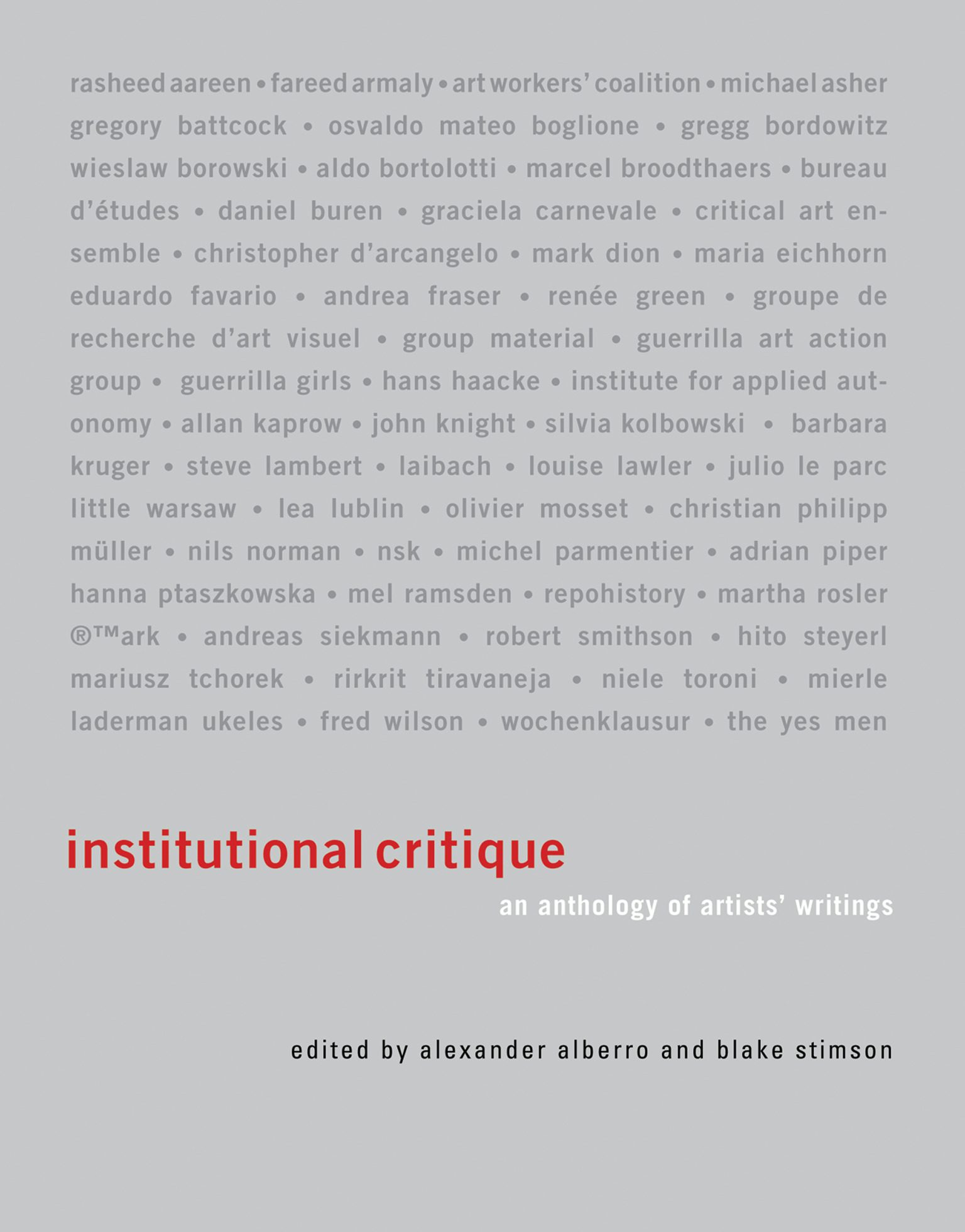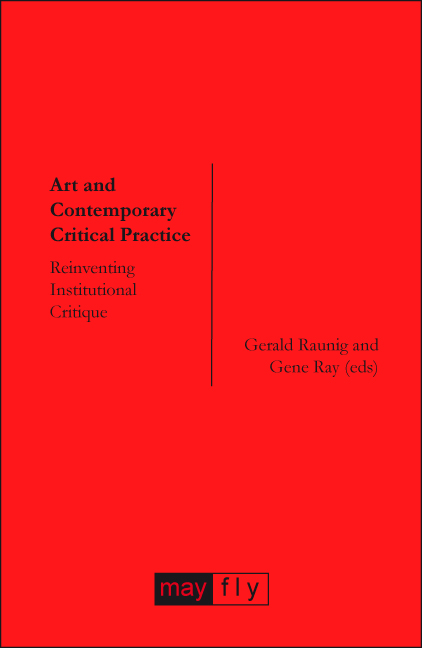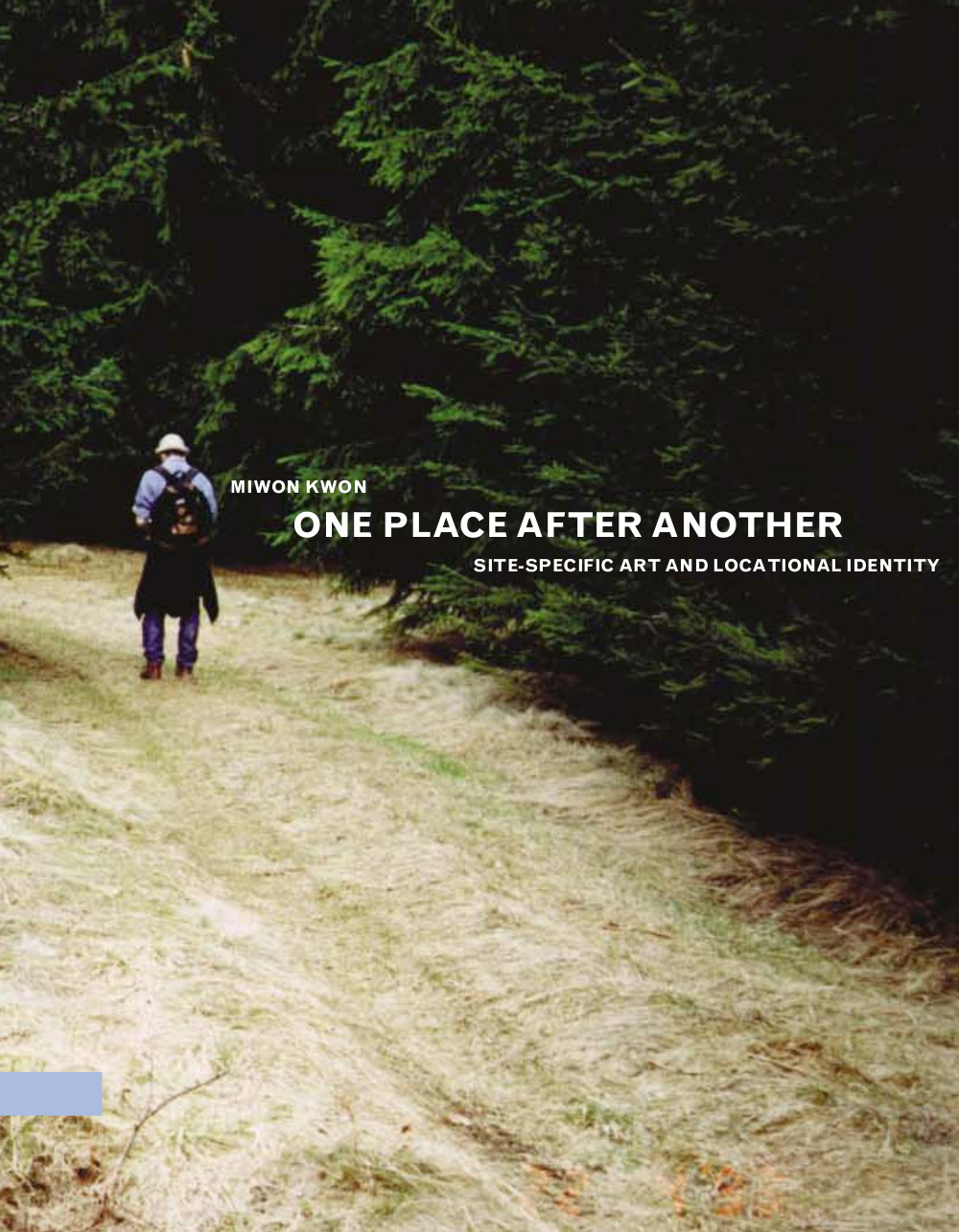Alexander Alberro, Blake Stimson (eds.): Institutional Critique: An Anthology of Artists’ Writings (2009)
Filed under book | Tags: · art, art criticism, art history, art system, art theory, artistic research, contemporary art, critique, institutional critique

“‘Institutional critique’ is an artistic practice that reflects critically on its own place within galleries and museums and on the concept and social function of art itself. Such concerns have always been a part of modern art but took on new urgency at the end of the 1960s, when—driven by the social upheaval of the time and enabled by the tools and techniques of conceptual art—institutional critique emerged as a genre. This anthology traces the development of institutional critique as an artistic concern from the 1960s to the present, gathering writings and representative art projects of artists who developed and extended the genre. The artists come from across Europe and throughout North America. The texts and artworks included are notable for the range of perspectives and positions they reflect, and for their influence in pushing the boundaries of what is meant by institutional critique.
Like Alberro and Stimson’s Conceptual Art: A Critical Anthology, this volume will shed new light on its subject through its critical and historical framing. Even readers already familiar with institutional critique will come away from this book with a greater and often redirected understanding of its significance.”
Artists represented include: Wieslaw Borowski, Daniel Buren, Marcel Broodthaers, Groupe de Recherche d’Art Visuel, Hans Haacke, Robert Smithson, John Knight, Graciela Carnevale, Osvaldo Mateo Boglione, Guerilla Art Action Group, Art Workers’ Coalition, Mierle Laderman Ukeles, Michael Asher, Mel Ramsden, Adrian Piper, The Guerrilla Girls, Laibach, Silvia Kolbowski, Andrea Fraser, Fred Wilson, Mark Dion, Maria Eichhorn, Critical Art Ensemble, Bureau d’Études, WochenKlausur, The Yes Men, Hito Steyerl, Andreas Siekmann
Publisher MIT Press, 2009
ISBN 0262013169, 9780262013161
492 pages
PDF (10 MB, no OCR; updated on 2023-2-14)
Comments (2)Gerald Raunig, Gene Ray (eds): Art and Contemporary Critical Practice: Reinventing Institutional Critique (2009)
Filed under book | Tags: · art, contemporary art, critique, institutional critique, political theory

“‘Institutional critique’ is best known through the critical practice that developed in the late 1960s and early 1970s by artists and activists who presented radical challenges to the museum and gallery system. Since then it has been pushed in new directions by new generations exploring this legacy and developing the models of institutional critique in ways that go well beyond the field of art. The contributors to the eipcp-project transform as well as to the book that assembles some of the most important theoretical contributions to the project interrogate the shifting relations between ‘institutions’ and ‘critique’ proposing new concepts as ‘monster institutions’, ‘instituent practices’ and ‘institutions of exodus’.”
With texts by Boris Buden, Rosalyn Deutsche, Marcelo Expósito, Marina Garcés, Brian Holmes, Jens Kastner, Maurizio Lazzarato, Isabell Lorey, Nina Möntmann, Stefan Nowotny, Gerald Raunig, Gene Ray, Raúl Sánchez Cedillo, Simon Sheikh, Hito Steyerl, Universidad Nómada, and Paolo Virno.
Publisher: mayfly, London; in conjunction with the European Institute for Progressive Cultural Policies
Creative Commons licence
ISBN 9781906948023
266 pages
Miwon Kwon: One Place after Another: Site-Specific Art and Locational Identity (2002)
Filed under book | Tags: · art, art history, collaboration, collaborative art, institutional critique, participation, site-specific art

“Site-specific art emerged in the late 1960s in reaction to the growing commodification of art and the prevailing ideals of art’s autonomy and universality. Throughout the 1970s and 1980s, as site-specific art intersected with land art, process art, performance art, conceptual art, installation art, institutional critique, community-based art, and public art, its creators insisted on the inseparability of the work and its context. In recent years, however, the presumption of unrepeatability and immobility encapsulated in Richard Serra’s famous dictum “to remove the work is to destroy the work” is being challenged by new models of site specificity and changes in institutional and market forces.
One Place after Another offers a critical history of site-specific art since the late 1960s and a theoretical framework for examining the rhetoric of aesthetic vanguardism and political progressivism associated with its many permutations. Informed by urban theory, postmodernist criticism in art and architecture, and debates concerning identity politics and the public sphere, the book addresses the siting of art as more than an artistic problem. It examines site specificity as a complex cipher of the unstable relationship between location and identity in the era of late capitalism. The book addresses the work of, among others, John Ahearn, Mark Dion, Andrea Fraser, Donald Judd, Renee Green, Suzanne Lacy, Inigo Manglano-Ovalle, Richard Serra, Mierle Laderman Ukeles, and Fred Wilson.”
Publisher MIT Press, 2002
ISBN 0262112655, 9780262112659
230 pages
PDF (updated on 2012-8-3)
Comment (0)
